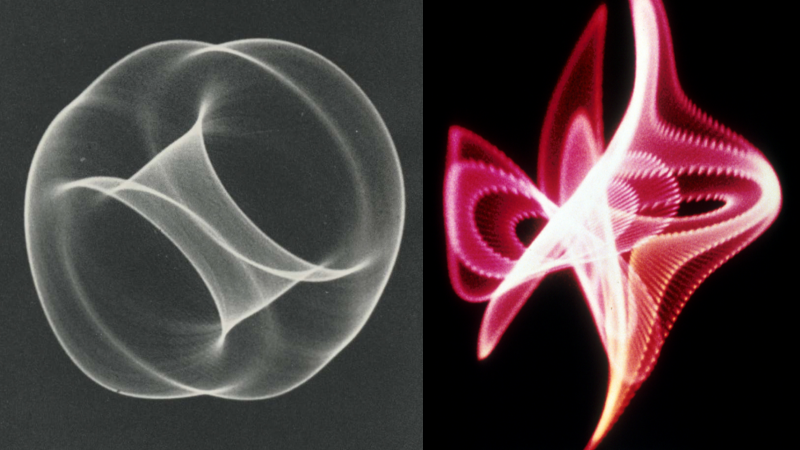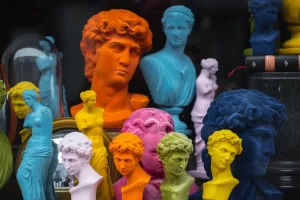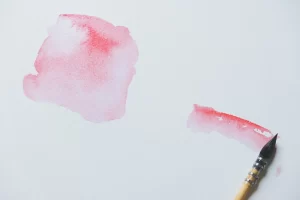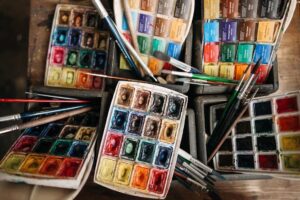Origins of Digital Art History
The beginnings of digital art history is often traced to early experiments in the 1950s and 60s with Ben F. Laposky and his “Oscillons”
“using a cathode ray oscilloscope along with electronic circuits like sine wave generators. He captured the moving outputs using long exposure photography. In later pieces, he rotated filters in front of the screen to add colour to the images.” -Amy Goodchild
If you didn’t get that, the featured image in this article are the Oscillons by Ben F. Laposky. To put it simply, he used machines and math to make light move around and then he photographed the result. This, in no way relates to digital art as it is today, but it’s fun to think about where it all might have started.
Fast forward to 1963 with Bell Labs, the IBM computer, and Ken Knowlton who invented BEFLIX- the world’s first pixel based animation program. BEFLIX allowed input to generate computer graphics made up of small squares; then called mosaics, now known as pixels.
Other influential projects of the time, also created by Bell Labs, with the support of IBM, were the Graphic-1 computer and the light pen. These were a precursor to today’s modern graphics tablets which most digital artists use today. With the light pen, users could create points and lines by drawing them directly onto the screen.
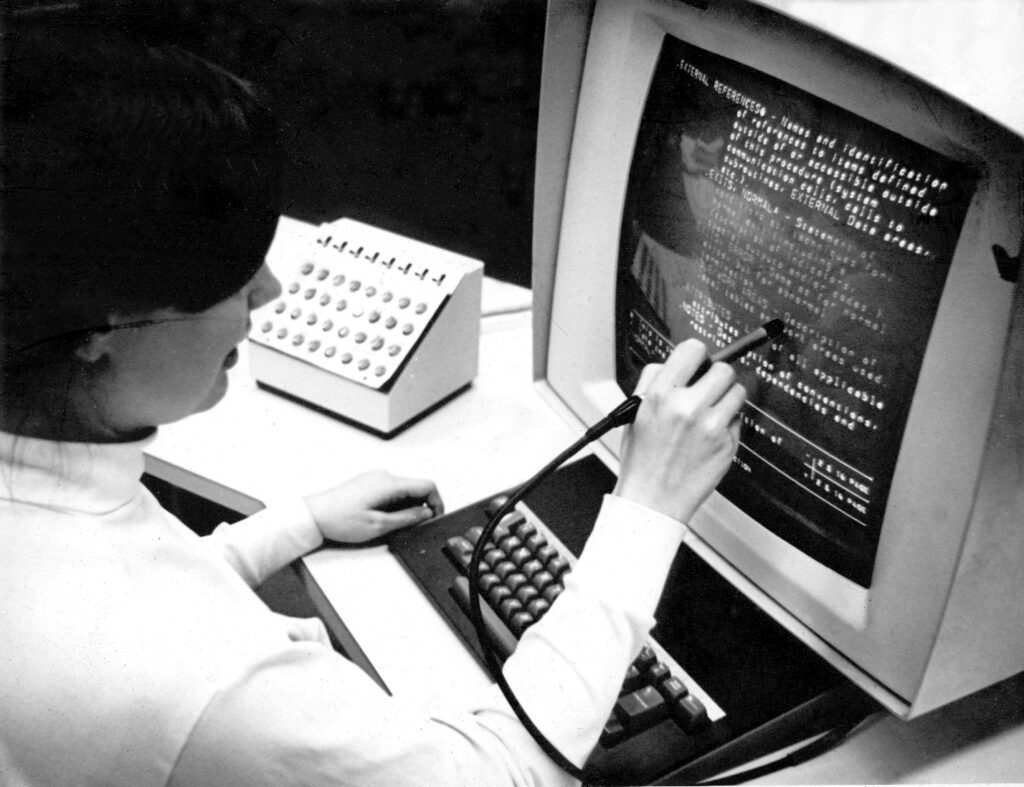
Digital Art History from the 1970s to 90s
In the 1970s, technology propels digital art forward with the advent of the personal computer, which allowed people to work with computers to generate even more artwork. One of these people was Harold Cohen, an artist in California that built an AI Art program Called AARON. This AI was, to some degree, capable of making unique and original artworks, just like the AI Art software available to us today.
In the 1980s came the Macintosh computer which made digital art even more accessible to the general public. In 1988 and 1989 respectively, Photoshop and Corel Draw were created. Digital art, or computer generated art became more and more the result of direct user input, rather than mathematical calculations and programming. People could actually make art on their computers. Even 3D CGI graphics were a thing in the 80s. In 1982, Walt Disney created the Movie- Tron, which was a huge milestone for the animation industry.
Most personal computer works were created through the use of collage but some even drew images. Perhaps the most notable work is Susan Kare’s Geisha, created in 1984 as an advertisement to showcase the creative capabilities of Macintosh Computers. Countless Artists of the time went digital, exploring what computers had to offer them, and mainly were rejected by most art institutions for having no substance.


The 2000s: Digital Art Goes Mainstream
The early 2000s marked a pivotal era in the realm of digital art, characterized by the rapid evolution of technology and the introduction of groundbreaking platforms. This period witnessed the fusion of traditional artistry with digital innovation, leading to the emergence of animation video games, the widespread adoption of social media, and various other technological advancements that expanded the canvas of digital artists.
Animation and video games took a significant leap forward, as developers began to harness more powerful computing resources and sophisticated software. This era saw the birth of games that were not only entertaining but also works of art in their own right, featuring complex narratives, immersive worlds, and stunning visual effects. The boundary between player and spectator blurred as interactive art became a mainstream phenomenon.
Social media, emerging as a global force, provided digital artists with platforms to share their work, collaborate, and engage with audiences in real-time. Sites like DeviantArt, Flickr, and later Instagram, became digital galleries where artists could gain exposure, receive feedback, and connect with fellow creators and fans across the globe. This democratization of art distribution challenged traditional gatekeeping in the art world and fostered a more inclusive community of digital creators.
These advancements, along with the proliferation of digital tools and technologies, such as tablets and digital painting software, empowered artists to experiment and create in ways that were previously unimaginable. The early 2000s set the stage for digital art to become an integral part of the cultural zeitgeist, influencing not only the art world but also entertainment, advertising, and social interaction. This era laid the foundation for the digital art landscape as we know it today, characterized by its diversity, accessibility, and boundless potential for innovation.
Contemporary Digital Art
In the ever-evolving landscape of the art world, cutting-edge trends and technologies are reshaping how we create, experience, and interact with art. Among these, Virtual Reality (VR), Augmented Reality (AR), and Artificial Intelligence (AI) art stand out as revolutionary tools that are not only expanding the boundaries of artistic expression but also enhancing our engagement with art in unprecedented ways.
Virtual Reality (VR) has opened new dimensions for artists and audiences alike, offering immersive experiences that transport viewers into entirely fabricated worlds or reimagined real-world scenarios. This technology enables creators to construct interactive environments where the spatial and sensory limitations of traditional art are transcended, allowing for a deeper emotional and cognitive connection.
Augmented Reality (AR), on the other hand, bridges the gap between the digital and the physical. By overlaying digital information onto the real world, AR allows artists to add layers of interaction and meaning to physical spaces and objects. This fusion of digital and real-world elements creates a unique platform for storytelling and artistic expression, making art more accessible and engaging for audiences.
Artificial Intelligence (AI) art introduces a new player in the creative process. AI algorithms can generate art that mimics the styles of historical masters, create original works based on data inputs, or collaborate with human artists to push the boundaries of creativity. The use of AI in art raises intriguing questions about authorship, creativity, and the role of technology in the artistic process.
Together, VR, AR, and AI are not just tools for creating art; they are reshaping our understanding of what art can be and how it can be experienced. As these technologies continue to develop, they promise to further blur the lines between creator, viewer, and medium, offering new opportunities for innovation and interaction in the art world.
The role of digital art in social and political discourse
Digital art has emerged as a powerful medium in social and political discourse, offering artists a dynamic platform to express opinions, challenge perceptions, and catalyze change. Through its accessibility and immediacy, digital art transcends geographical boundaries, enabling creators to share their messages with a global audience instantly. The visual nature of this medium, combined with the viral potential of social media, allows impactful ideas and narratives to spread rapidly, engaging diverse communities in conversations about pressing social and political issues.
Moreover, digital art’s versatility in form—from digital illustrations and memes to complex animations and interactive installations—makes it an effective tool for capturing attention and provoking thought. By visualizing abstract concepts, highlighting injustices, and imagining future possibilities, digital artists play a crucial role in shaping public opinion and inspiring action. In this way, digital art not only reflects the current socio-political climate but also contributes to the discourse, challenging viewers to reflect, question, and, ultimately, contribute to societal transformation.
Future Perspectives
The future of digital art is poised for unprecedented growth, driven by rapid technological advancements and the expanding creative possibilities they offer. We are likely to see the further integration of Artificial Intelligence (AI), Virtual Reality (VR), and Augmented Reality (AR) into the creative process, pushing the boundaries of what is possible in digital canvases.
AI, with its ability to learn and create, could partner with artists to produce works that blend human emotion with algorithmic complexity, offering new perspectives and styles that have yet to be imagined. VR and AR will continue to redefine the spatial and experiential aspects of art, allowing for more immersive and interactive artworks that engage audiences in multi-sensory experiences, blurring the lines between the digital and the physical worlds.
Moreover, the democratization of art creation and distribution through digital platforms will likely accelerate, enabling artists from diverse backgrounds to share their work with global audiences and participate in digital art communities. This inclusivity could lead to a rich tapestry of artistic expression that reflects a broader spectrum of human experience. As digital technology becomes more integrated into our daily lives, digital art will not only become more prevalent in traditional galleries and museums but will also play a significant role in public spaces, social media, and virtual environments, continually reshaping our cultural landscape and how we interact with art.
Conclusion
As we journey through the remarkable timeline of digital art’s evolution, from Ben F. Laposky’s pioneering “Oscillons” to the sophisticated realms of VR, AR, and AI art, it’s clear that this is not just a history of technology, but a history of human imagination and its boundless capacity to evolve. Digital art has transcended its early experimental stages to become a profound medium for creative expression, societal reflection, and political discourse. The early 2000s marked a significant turning point, democratizing art creation and distribution, and setting the stage for the dynamic, inclusive, and innovative landscape we navigate today.
Looking forward, the trajectory of digital art promises even greater integration of emerging technologies, further blurring the lines between the digital and physical, the creator and the viewer. As we anticipate these developments, it’s evident that digital art will continue to challenge our perceptions of what art is and what it can be. The journey from Laposky’s oscilloscope experiments to today’s digital canvases reflects not only technological advancement but a deeper shift in how we perceive and interact with art. In this ever-changing landscape, one thing remains constant: the relentless pursuit of creativity and the unending quest to capture the essence of the human experience through digital means.
References
https://www.amygoodchild.com/blog/computer-art-50s-and-60s
https://en.wikipedia.org/wiki/Ben_F._Laposky#cite_note-4
https://www.youtube.com/watch?v=IL7dsFtauN4
https://www.youtube.com/watch?v=_Lmi6cmrq0w
https://hackaday.com/2023/05/19/early-computer-art-from-the-1950s-and-1960s/
https://www.youtube.com/watch?v=6bI164G26dg
https://worldart.news/2023/01/23/brief-history-of-digital-art/

